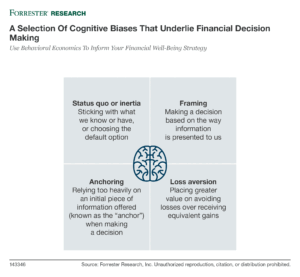Five (Plus One) Must-Reads On Behavioral Economics
I’ve spent the past three weeks interviewing global financial institutions, fintech startups, and technology vendors to gain a broader perspective on how financial experiences will evolve in the coming years. Financial services firms and innovative startups of all stripes are all set on offering more holistic and personalized customer value propositions that support and sustain customers’ financial well-being.
Many of them have started using behavioral economics. Banks, insurance companies, and fintech startups apply behavioral insights to the design of their applications to nudge customers toward better financial decisions and help them achieve their financial goals.
If you’re interested in learning more about how digital strategy executives in financial services organizations apply behavioral economics principles to their financial well-being strategy and design engaging digital financial experiences that bridge the “intention-action gap,” I invite you to read my report “Use Behavioral Economics To Inform Your Financial Well-Being Strategy.”
What’s Behavioral Economics?
Decades of behavioral science research have revealed that humans are not naturally predisposed to making logical, conscious choices and therefore don’t always do what’s best for them. When making decisions, subconscious cognitive biases lead people to systematic deviations from a standard of rationality or good judgment. Cognitive biases can degrade all types of decisions, including those related to money and investing.

As Professor of Psychology and Behavioral Economics Dan Ariely writes in his book Dollars and Sense: How We Misthink Money and How to Spend Smarter, “Emotions play a powerful role in shaping our financial behavior, often making us our own worst enemies.” Practitioners have suggested that it is possible to use behavioral insights to help individuals and groups make better decisions — whether it is about their health, finances, or even the environment they live in.
Nudge theory provides tactics to propel behavioral change. Concepts of modern psychology and behavioral economics have begun to suggest ways to design better programs, policies, and products. In their seminal 2008 work Nudge: Improving Decisions About Health, Wealth, and Happiness, Nobel laureate Richard H. Thaler and Harvard Law School Professor Cass R. Sunstein developed the concept of nudge theory, which suggests that consumer behavior and decision making can be influenced by positive reinforcement and suggestions without restricting their sense of freedom. An example of these nudges in the case of retirement is automatic enrollment of employees in a workplace pension scheme while giving them the possibility to opt out.
Choice architecture provides structure to successfully nudge people. Thaler and Sunstein argue that because there’s a propensity among many people to take the path of least resistance when confronted with a choice of options, organizations and institutions should ensure that they incorporate human psychological factors into the design of their policies, systems, and products. Those who indirectly influence the choices other people make through design are, in their words, “choice architects.” Choice architects can deliver well-designed systems and improve the outcomes for users by structuring and simplifying complex choices, providing incentives, and offering feedback.
Selected Reading List
If you’re interested in further reading on this fascinating topic, try one of these five books:
Nudge: Improving Decisions About Health, Wealth, and Happiness, by Richard H. Thaler and Cass R. Sunstein (2008). This is the bible of behavioral economics. A The Economist and Financial Times book of the year, this book-turned-manifesto teaches us how governments, agencies, charities, and companies can better design their policies, systems, and products for our individual and collective well-being.
Thinking, Fast and Slow, by Daniel Kahneman (2011). If you’re interested in learning about “System 1” and “System 2,” our two modes of decision thinking, and the flaws of intuitive thought, this one is for you. In Nassim Taleb’s words, “A landmark book in social thought, in the same league as The Wealth of Nations by Adam Smith and The Interpretation of Dreams by Sigmund Freud.” ‘Nuff said.
Dollars and Sense: How We Misthink Money and How to Spend Smarter, by Dan Ariely and Jeff Kreisler (2017). This book provides the practical tools we need to make better financial decisions and is written in a very engaging and funny way, with lots of anecdotes and “free advice.” (Although, as the saying goes, “There’s no such thing as free advice” — the book will cost you a few bucks on Amazon!)
Hooked: How to Build Habit-Forming Products, by Nir Eyal (2014). This book provides a good toolkit for designers, developers, product managers, and startup founders who care about driving customer engagement and building habit-forming products. It offers a simple and practical user engagement model based on four stages (trigger, action, variable reward, and investment) and combines experience and knowledge in technology and consumer psychology to design addictive products or services. Remember, though — as Richard Thaler often autographs his books — “nudge for good.”
The Undoing Project: A Friendship That Changed Our Minds, by Michael Lewis (2017). This has been one of my favorite reads of 2017. In his book, Michael Lewis (the writer of Flash Boys: A Wall Street Revolt — for those who’ve seen “The Big Short,” which was made after Lewis’ book on high-speed scamming) tells the touching and remarkable story of Tversky and Kahneman’s friendship and how their collaborative work changed the way we see the world, paving the way for the birth of behavioral economics.
I hope you will enjoy reading these books and my report.
If you’d like to be interviewed as part of our research on financial well-being, please reach out to me at alhostis@forrester.com.
